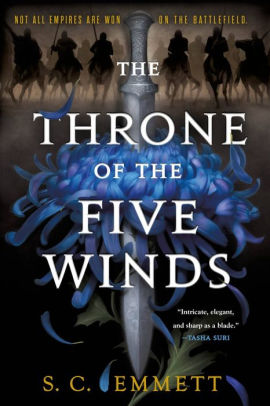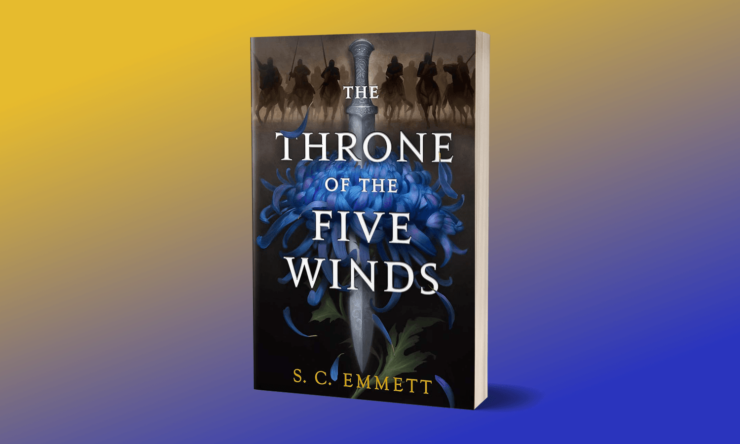For all of the tendency in fantasy lately to look at perspectives outside of the aristocratic, the powerful, and the noble, there is a satisfaction in that mode of epic fantasy. Sometimes you want the people at the center of power, the classic rock of epic fantasy where the movers and shakers, and those adjacent to them scheme, jockey and manipulate each other. Multiple viewpoints and perspectives, but generally from that social class help make it seem like a pressure cooker of intrigue and drama. So it is with S.C. Emmett’s The Throne of the Five Winds.
S.C. Emmett is one of author Lilith Saintcrow’s many pseudonyms, covering a wide variety of SFF genres. The Throne of Five Winds marks her first foray into classic secondary world epic fantasy, using an East Asian model for her worldbuilding, rather than the more stereotypical Western European. The novel is first in the Hostage of Empire series, which gives a bit of a clue as to what is going on.
The Empire of Zhaon, modeled on aspects of several Chinese dynasties, is where the action takes place. With a few brief exceptions, all that occurs happens not only within Zhaon, but in or near to the royal palace of Zhaon, with a deadly decadent court approach to epic fantasy. Zhaon, forged from smaller entities into a larger empire, has some potent neighbors—the northern, colder realm of Khir feels primarily based on something like the Khitans (Liao dynasty), with a strongly patriarchal society. Zhaon has humbled the Khir, and the thrust of the book is that a Khir Princess is being sent to wed the Emperor’s firstborn son, the First Prince. A Crown Princess bride for a Crown Prince, especially given the failing health of the Emperor, should be a joyous thing, save that it threatens the status of all of the other members of the family. The First Queen, whose son (the Second Prince) is the first to be born during the Emperor’s reign, has her own ideas as to who should succeed her husband. Back in Khir, there are those not happy with Princess Mahara being sent off to Zhaon, and dream of freeing her from such shame, and freeing their land from Zhaon domination in the bargain. And they do more than just dream.
And so the court intrigue is set. Add in additional princes and princesses, plus a General who has been adopted by one of the royal Concubines into the Family, and you have a set of conflicting personalities with crossed loyalties, agendas, plans, fears, and concerns as the Emperor is clearly fading, even if few want to admit it. For a 650-page epic fantasy, the cast is actually somewhat limited, focusing instead on intense and concentrated character relationships.
Our major point of view, though, is not Mahara as one might expect, but rather Yala. Yala is a noblewoman and the only lady in waiting to be sent with Mahara south to the court (the expectation was for a whole retinue), and much revolves around her. Capable, quick, intelligent, and fiercely loyal to Mahara, she provides a figure for the audience to really identify with. In many ways she is the center of the books action and focus. Given that she is the only companion of a foreign princess come to court, she is a natural focal point of interest on the part of members of the Court, and thus for the narrative as well.
Buy the Book


The Throne of the Five Winds
That narrative, that story, wedded and part and parcel of the concerns and fears of members of the Court and beyond, really drives the narrative. The novel has its share of assassination attempts and some moments of physical conflict, but the beats, the frame and the shape of this story is very much in the psychological and emotional. The novel is a very slow burn in that regard. While dislike for Mahara is evident early, the actual gears of the plot and the central matter of the novel take a long time to build up. The novel spends that time setting up the chess board, letting us get to know the various factions and players of the game, before setting events fully in motion. Readers impatient for immediate explosive results are going to be disappointed. I, however, think that the author does an excellent job in arranging matters before unleashing the full power of action, on all axes. I came to understand and sympathize with all corners of the conflicts and the various factions. Everyone has a point, although their methods can be rather deplorable.
The novel is very light on fantastic elements beyond taking place in another world. There are no displays of magic, wuxia, martial arts, supernatural creatures, or the like. Sure, there are creatures, plants, foods, poisons, and concepts that do not exist in our world, but readers looking for a truly alien secondary fantasy world are going to be disappointed. The world is close to our own, the characters entirely human, and their concerns, fears and actions entirely within our ken. While individual elements are unique, Emmett/Saintcrow successfully evokes a East Asian that never was in the cultural details and touches that she brings to her world. It never feels like she is strictly aping any particular historical place or country, but there are definite inspirations and intimations throughout the book. In the end this DOES feel like a land at the far end of the Silk Roads. In terms of social terns, the world is a very culturally conservative one, with strictures on action, duty and response to dishonor. The world is also extremely heteronormative in terms of depicted sexuality. The book also includes footnotes, used exclusively for definitions and explanations of things to extend that rich world. As such, I don’t think they are used quite as effectively as in Alix Harrow, Jenn Lyons or Alex Rowland’s work, which are much more willing to use metatext as well.
The Throne of the Five Winds is, in the end, for readers who want an East Asian-inspired big fat epic fantasy (in terms of page count) with a narrow and focused set of characters at the heart of power, that is not too far different from our own world. It’s also for readers who definitely want court intrigue, melodrama, and circumscribed action instead of grand battles, physical conflicts, and the like. It’s well written, and the novel’s narrative momentum and characters carried me through to the end and I enjoyed the experience. I’d return to these characters and this world.
The Throne of the Five Winds is available from Orbit.
An ex-pat New Yorker living in Minnesota, Paul Weimer has been reading sci-fi and fantasy for over 30 years. An avid and enthusiastic amateur photographer, blogger and podcaster, Paul primarily contributes to the Skiffy and Fanty Show as blogger and podcaster, and the SFF Audio podcast. If you’ve spent any time reading about SFF online, you’ve probably read one of his blog comments or tweets (he’s @PrinceJvstin).










